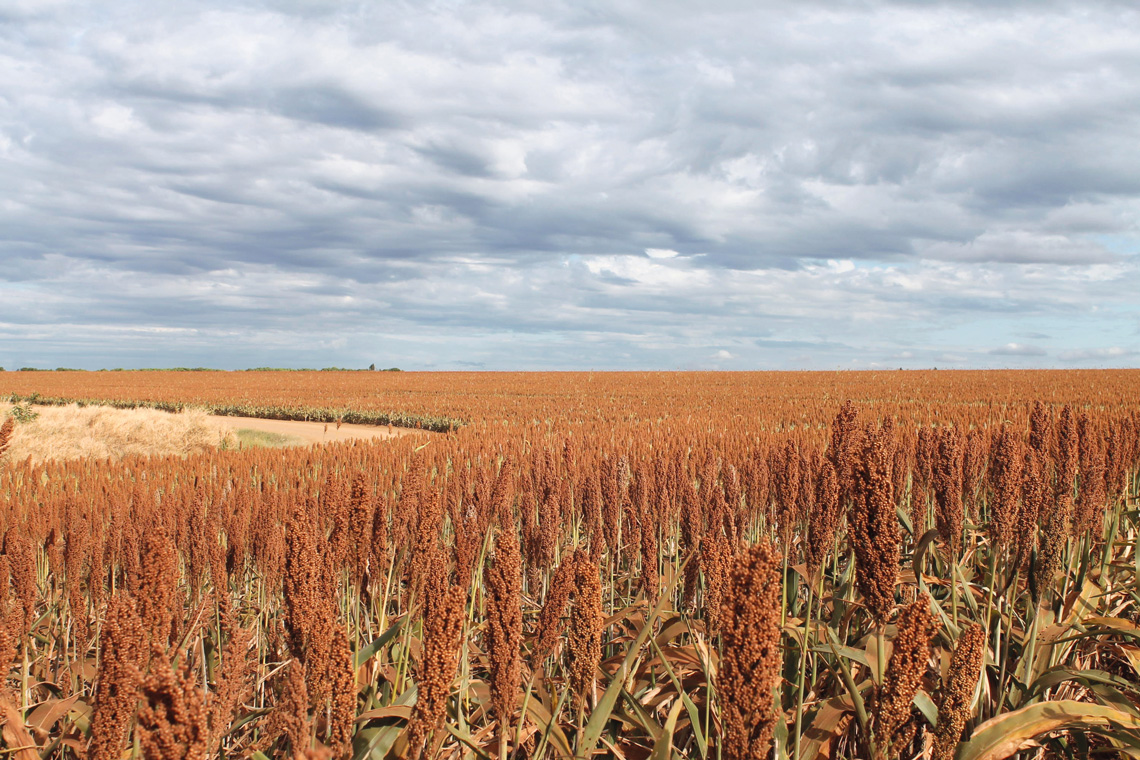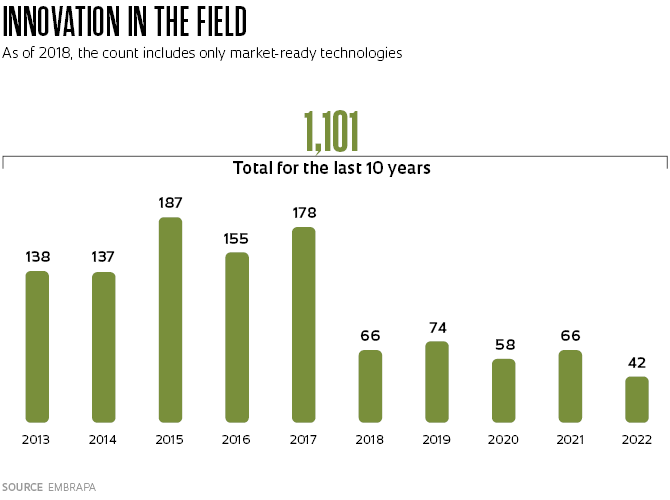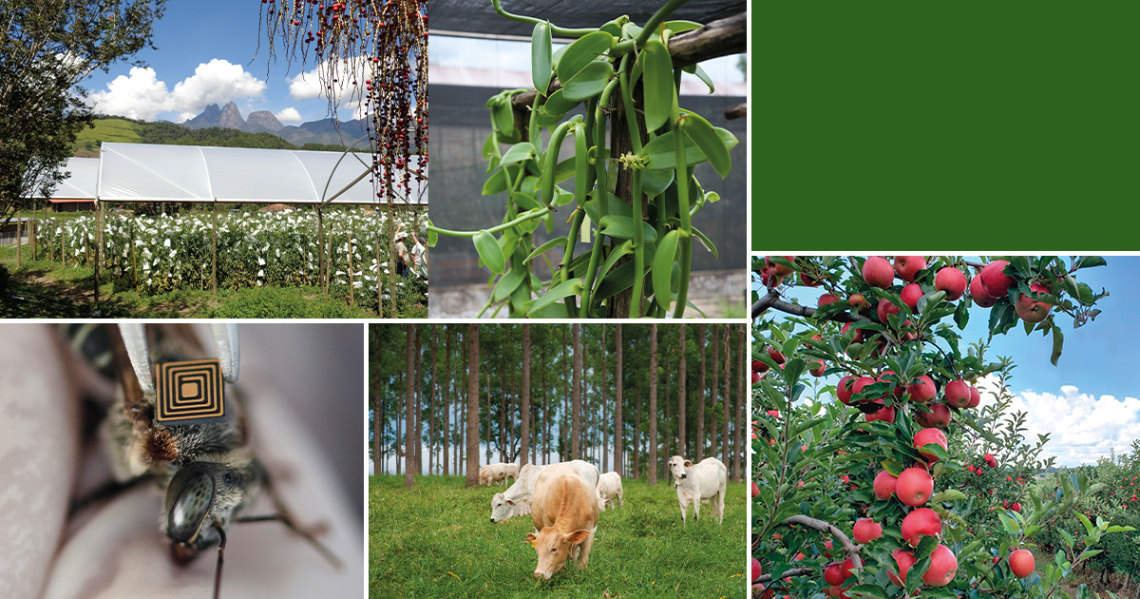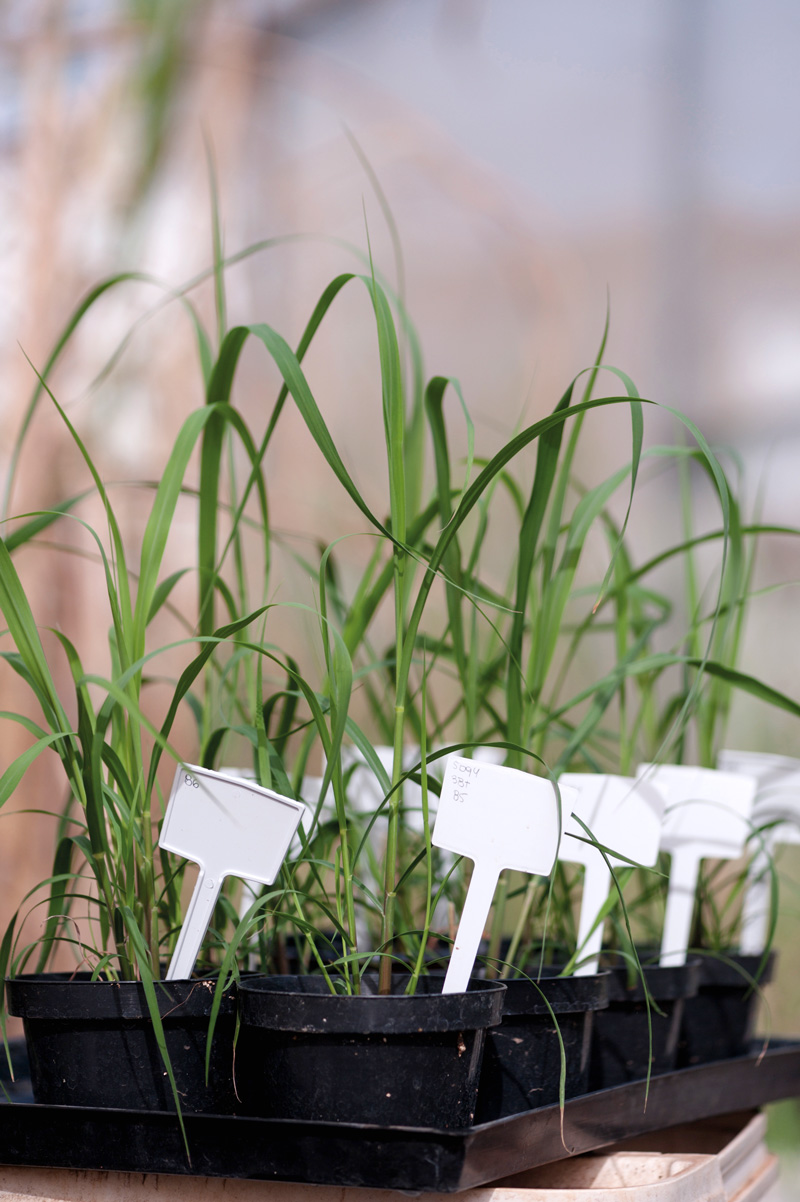Agricultural engineer Tatiana de Sá, from the Eastern Amazon branch of EMBRAPA (the Brazilian Agricultural Research Corporation), in Belém, makes a four-hour trip nearly every month, usually by bus or car, to work with farmers in Santa Luzia do Pará, in eastern Pará State. Together, they select the best ways to cultivate and make use of three root plants—arrowroot and purple and white yams—and three fruit crops—banana, tucumã (Astrocaryum aculeatum palm), and peach palm. Their goal is to eliminate an old problem: losing root crop and fruit harvests due to the difficulty of selling and storing them.
Farmers from the Santa Luzia region also go to the EMBRAPA unit in Belém to talk to the Agribusiness Lab team about ways to prepare flour, pasta, bread, and biscuits with the root and fruit crops they grow. “The techniques for growing and using arrowroot were being forgotten because of the dominance of wheat, the main enemy of food sovereignty in the Amazon,” comments Sá, who was hired in 1972 by the Northern Brazil Agricultural Research Institute (IPEAN), which was later incorporated into EMBRAPA. “The residents of the Santa Luzia region were interested in planting native roots, which were being lost.”
Recognizing local knowledge and organizing production through associations and small farmer unions are precepts of agroecology, an approach that advocates agricultural diversification and the preservation of natural resources. Valued as a response to international pressure on Brazil and its rural producers, who are increasingly being asked to prevent environmental damage caused by the practice of monoculture and the intensive use of pesticides, this approach is gradually gaining ground at EMBRAPA, an institution that will have been in operation for exactly 50 years on April 26.
“Organic agriculture—an area of agroecology—was seen as a utopia 30 years ago, but today it’s recognized worldwide and taught in university courses,” says agronomist Jose Antonio Azevedo Espindola, a researcher at EMBRAPA Agrobiologia, in Seropédica, Rio de Janeiro, and chairman of the management committee for its ecologically based production systems portfolio.
The environmentally friendly agriculture proposed by the agroecology movement follows principles that are quite different from the model that has previously given direction to EMBRAPA and other agricultural research institutions in Brazil. It has been guided by a high-production paradigm based on mechanization, intensive use of fertilizers and pesticides, and mass crop cultivation on extensive properties, which has greatly increased national agricultural production.
“Soybeans, which previously were not found north of Paraná, today are grown in the Legal Amazon. Brazilian sparkling wines win international awards. Apples used to only come from Argentina, because there were no national varieties. We went from being food importers to exporters, and today Brazil is the third largest food exporter in the world,” observes physicist Silvio Crestana, a former director and researcher at EMBRAPA Instrumentação, one of five units that FAPESP has supported in the state of São Paulo since 1991, through 927 research projects and grants totaling R$97.9 million.
Crestana, who was the director of EMBRAPA from 2005 to 2009, believes these achievements should not overshadow the future: “We now have to think about the social and environmental impacts of agriculture, because the world and the majority of producers and consumers want it that way. It is fundamental to rebuild EMBRAPA so that it can rise to these new challenges.”
Agronomist Irene Cardoso, from the Federal University of Viçosa (UFV), in Minas Gerais, points out that “Agricultural research institutions, not just EMBRAPA, need to pay more attention to other forms of agriculture, such as family and traditional agriculture, without chemical fertilizers and without pesticides.” The former president of the Brazilian Association of Agroecology (ABA), Cardoso adds that agribusiness, to which the history of EMBRAPA is closely linked, “is not environmentally sustainable, as it causes a reduction in biodiversity and extreme emissions of greenhouse gases because of deforestation and fires.” Tatiana de Sá adds, “EMBRAPA cannot be homogeneous, because its public isn’t.”

Sorghum production in a crop-livestock-forest integration system in the Cerrado region of MaranhãoLéo Ramos Chaves / Revista Pesquisa Fapesp
Agronomist Celso Moretti, the president of EMBRAPA since 2019, told Pesquisa FAPESP that the country’s largest agricultural research institution is already quite eclectic. “Our studies are developed to serve all farmers, of every profile, without biases, with a focus on increasing productivity, adding value to the product, and sustainability,” he says. “We do research both for improving products aimed at export—like commodities—as well as those for domestic consumption, which pertains to most small farmers and organic and agroecological agriculture.”
Moretti observes that EMBRAPA has a practical problem, a failure to replace employees who have left or retired over recent years: “The last time we hired new researchers was in 2014, through a 2010 civil service exam.” Agronomist Heitor Cantarella, director of the Agronomic Institute of Campinas (IAC), voices a similar complaint. “To refresh our lines of research and plan agriculture for the next 20 years, we need to rejuvenate EMBRAPA’s research team. During the last 15 years we lost 40% of our employees, who weren’t replaced because there aren’t any civil service exams being conducted,” he says.
Cantarella recognizes the social pressure in favor of food production methods that have fewer environmental impacts and lower greenhouse gas emissions. He argues that the most recent research—even if based on a conventional approach—seeks to reduce the use of pesticides, for example, by selecting varieties of plants that are naturally more resistant to pests and diseases and promoting so-called agricultural intensification, which entails producing more food with the same land area.
But are these concrete signs of renewal? “The technological paths of the conventional paradigm, which I call the mechanical-chemical model, are reacting to the problems of the ecological crisis through a solution that remains within the paradigm: an attempt at “greening” the path with biological solutions that, in general, are at the service of mechanics and chemistry,” says economist Francisco de Assis Costa, from the Federal University of Pará (see Pesquisa FAPESP issue nº 277). Cantarella observes: “Ecological agriculture will continue to increase, but it will have to coexist with some version of ‘mechanical-chemical’ agriculture, because of the pressure to produce abundant, low-cost food and raw materials.”

The disproportion between the size of teams allocated to the two differing approaches to research and agricultural production is another challenge. “At EMBRAPA,” says Espindola, “the percentage of researchers involved in generating technological solutions adapted for conventional agriculture is still much higher than the number dedicated to agroecology and organic production, but we’re making progress.” For Moretti, the number of researchers is not a good indicator of a research area’s relevance: “With focus and work capacity, it’s possible to deliver what’s necessary to meet the differing demands.” After doing an intensive study on grains, such as soy, corn, or cotton, most researchers are dedicated to other crops, but also with a high-production bias.
The EMBRAPA president further observes that the teams dedicated to research on carrot and tomato production, although small, have achieved important results. In 2020, the institution launched a carrot cultivar (variety) for organic production, which is recommended for planting during the off-season of conventional cultivars. Meanwhile, Tomatec is a growing system launched in 2005 which uses drip irrigation and integrated pest management.
Forestry engineer Édson Luis Bolfe, the former coordinator of Agropensa, a research division created to help EMBRAPA and its partner institutions formulate research strategies, sees a gradual improvement in agricultural production systems. “In the same way that direct planting was a novelty in the 1970s, integrated crop, livestock, and forest systems will evolve and consolidate in the coming years with greater food production and less pressure on natural resources.”
As a researcher at EMBRAPA Agricultura Digital in Campinas, São Paulo, Bolfe worked with colleagues from other institutions to develop methods for accurately mapping the boundaries, diversification, expansion, contraction, or conversion of various agricultural crops, by combining a variety of satellite images. Tested in municipalities in Goiás, Bahia, Maranhão, Mato Grosso, Mato Grosso do Sul, and São Paulo, the new approach maps native vegetation and differentiates plantations such as soy, corn, cotton, and sugarcane, as detailed in articles published in the journal Remote Sensing in 2022, and this year in the journal Land.
Currently employing 2,201 researchers (there were 2,437 in 2013), with a budget of R$3.6 billion for the most recent fiscal year (in current values, it was R$2.5 billion in 2003), EMBRAPA is a relatively recent addition to the oldest group of national agricultural research institutions. The Instituto Agronômico de Campinas (IAC) was created in 1887; the Luiz de Queiroz College of Agriculture (ESALQ) was launched in 1901 and later incorporated into the University of São Paulo (USP); the Agricultural School of Lavras, in Minas Gerais, began in 1908; and the Escola Superior de Agricultura e Veterinária de Viçosa, later integrated into UFV, dates back to 1920. But no other agency has as many branches—there are seven central units, located in the Federal District, and 43 spread throughout the states of Brazil.
“EMBRAPA is one of the big projects of the military government, and had a strong influence from the United States,” says historian Jefferson Sanches, a basic education and college entrance exam teacher in the public and private school systems of Vinhedo and Jundiaí, in the state of São Paulo. He observes that for the military government, the production model based on monoculture on large properties and bank loans with interest below inflation was a way of occupying the Midwest, undermining the concept that agrarian concentration was an obstacle to economic development, and a way to put off agrarian reform.
In a November 2022 article in Revista de História, he describes how EMBRAPA was formed through connections between the Brazilian government and American philanthropic organizations, including the Rockefeller and Ford foundations, which turned to promoting increased food production after their contributions to funding research on global health issues. He writes that EMBRAPA’s creation was inspired by prior efforts funded by US institutions, such as expanding the production of rice in the Philippines, wheat in Mexico, and potatoes in Peru. In this way, the Green Revolution, a strategy to increase productivity in the agricultural field that began in the United States in the 1960s, went global, encouraging the consumption of seeds, fertilizers, and equipment produced by American companies.
EMBRAPA assumed the functions of the Agricultural Research Department of the Ministry of Agriculture, with the mission of consolidating scientific investigations and coordinating between state-owned companies, many of which had been deactivated over the previous years. One of their initial priorities was to implement commercial agriculture in the central region of Brazil, which at that time was mostly untouched Cerrado (wooded savanna). Sanches explains that the development of new techniques gave science-based reinforcement to the occupation being led by shrewd farmers in the states of Rio Grande do Sul and Santa Catarina, who had purchased land at low prices. Methods of correcting soil acidity with limestone, direct planting the soil (without tilling, to avoid loss of nutrients), and the use of nitrogen-fixing bacteria became common. Sanches points out that the initial research that led to expanded agricultural production in this region was a doctoral thesis by Serbian scholar Nikolai Pulchritudoff, presented in 1971 at the University of California at Davis, in the United States. His study described the mineral deficiencies of the Cerrado and the ways they could be successfully ameliorated.
Sanches characterizes the creation of EMBRAPA as a sign of what he calls the “modernization of permanence,” an expression based on the concept of conservative modernization, created by the sociologist American Barrington Moore Jr. (1913–2005). “It was a reorganization of agricultural production without changing the land base, drawing on a narrative based on science and technology, according to which modernization would be the only path, and naturally beneficial,” he comments. In the book A modernização dolorosa (The painful modernization) (Zahar, 1982), agronomist José Graziano da Silva emphasizes that this process increased wealth concentration, income disparities, the rural exodus, and the exploitation of the agricultural workforce.



